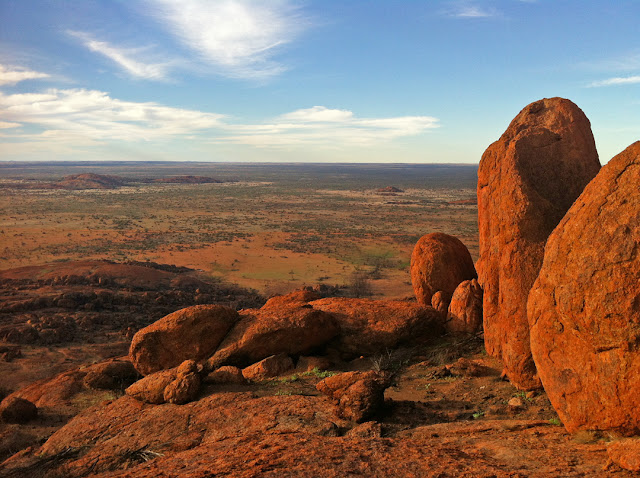
Flying into Yulara you can see Uluru (aka Ayer's Rock) on the left below the horizon.
![]()
![]()
I've been down in Australia for the last month working in Ernabella, Pukatja community. I've intentionally held off from blogging to let my mind settle. This trip has been about reflecting on the bigger picture whereas my first trip was all about absorbing the details. Last year I found myself swept up in the newness of the environment. Every sunrise, inma song and sgraffito pattern led me back to the question "Where am I?" Coming back to friends and an area that I now see as familiar has shifted this question to "Why am I here?"
![]()
Check out earlier posts in this series from last year's trip to Ernabella.
Way Outback: The Road to Ernabella
Way Outback: Night Writing
Way Outback: Chasing the Light
Way Outback: A Story for the Eyes
Way Outback: Animal Kingdom
Way Outback: Paint, Money, and Land
Way Outback: The Red Walls of Uluru


I've been down in Australia for the last month working in Ernabella, Pukatja community. I've intentionally held off from blogging to let my mind settle. This trip has been about reflecting on the bigger picture whereas my first trip was all about absorbing the details. Last year I found myself swept up in the newness of the environment. Every sunrise, inma song and sgraffito pattern led me back to the question "Where am I?" Coming back to friends and an area that I now see as familiar has shifted this question to "Why am I here?"
There is the obvious answer. I'm here working on a community service grant from the state of South Australia to encourage Anangu men to work with ceramics as a vocation. This is much needed with extremely high unemployment and no industry to speak of in the middle of the central desert. There is also a more nuanced answer. I am here to help a struggling community with a strong cultural identity express that identity through objects that also function commodities. The positive thing about this arrangement is that there is a strong market for paintings and ceramics that express Anangu identity. The not so positive part of the situation is that Anangu don't seem to think about time or financial need. Selling is not the main motivation for them to make art. This is generally a good perspective but selling can be a positive motivation to get a piece finished within a time frame that fits the ceramic process. Without an attachment to the final product one day projects turn into three day projects that don't get finished.
Much like last year I came down with grand visions about what could be achieved in the community. It is good to think big when you are in the planning stages of a project but its been a big reality check to see the lack of interest on the community's part. Its not that there aren't people in the studio working its just that they are the same men that I became friends with last year. I hoped we would expand our circle to include men that are my age or younger. I thought men would be jumping at the chance to increase their financial stability and therefore their status in the community. The reality is that most Anangu men want to hunt Kangaroo. Making ceramics is a hobby.
I'm not sitting in judgement writing this post as a complaint. I'm sitting here as a teacher trying to figure out how to motivate students who don't think learning what I am teaching is as important as I do. Isn't this the great dilemma of teaching? I don't have any immediate solutions but after a month I feel like I have my head screwed on straight about what my challenges are. I'm in the middle of readjusting my expectations to meet the student's needs as opposed to what I want them to need. I have one month left so I'll keep you posted on how this goes. For the time being I'm focusing all my attention onto the guys that are already in the studio. I'm hoping word will spread and other guys will migrate into the studio.
I'm also enjoying the hell out of the world class mountain biking that we have discovered in the area. Its been a huge thrill to ride thousands of feet of unexplored rock. You can see from the color of the earth in these pictures why they call this the Great Red Center.

Check out earlier posts in this series from last year's trip to Ernabella.
Way Outback: The Road to Ernabella
Way Outback: Night Writing
Way Outback: Chasing the Light
Way Outback: A Story for the Eyes
Way Outback: Animal Kingdom
Way Outback: Paint, Money, and Land
Way Outback: The Red Walls of Uluru


















































































